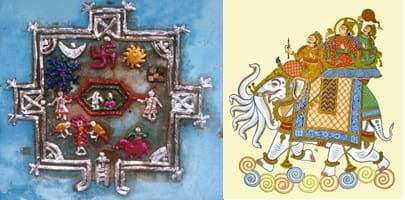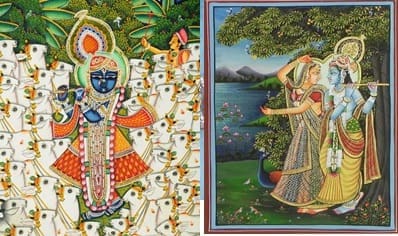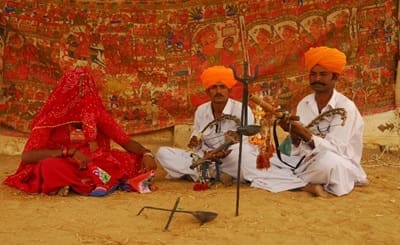India is known as land of culture and traditional vibrancy through its conventional arts and crafts. India has 35 states with their own style and pattern of art, which is known as folk art. Folk art in India has a great potential in the international market because of its traditional aesthetic sensibility and authenticity.1 A variety of art forms have evolved over the years; some untouched by modernization, some adapting to new paint colours and materials.2Indian folk art painting includes a brilliant battery of calendar and wall paintings, oilpaintings, canvas paintings, cloth paintings, cave paintings, miniatures and so on. The most famous types of Indian folk art paintings hence include various ancient Indian art forms such as Madhubani, Phad, Kalamkari, Orissa Paata, Warli paintings, etc. Indian folk art paintings usually deal with pictorial depictions of popular Hindu deities.
Folk paintingsof Rajasthan
Folk paintings in Rajasthan are as diverse as its culture. All the paintings are completely handmade. Rajasthan has the numerous talented painters;they bring art to the forefront. The folk paintings of Rajasthan deal with pictorial depictions of popular hindu gods, human portraits, common customs and rituals, and the elements of nature. Some of the popular folk paintings of Rajasthan includeSanjhya painting, phadpainting, pichwai painting and miniature painting.
Sanjhiya PaintingPhad Painting
Pichwai painting Miniature painting
PhadPaintings
Phad painting is originated in Bhilwara district of Rajasthan, India. It is a large painting on khadi or canvass.Small version of phad painting is known as ‘phadhye’.5 It is also spelled as par.6Phad or par is story telling tradition of the Rajasthan which is 400 years old.7Phad is possibly derived from Sanskrit word ‘Patt’. These paintings have a very specific styles of representation filled with figures and pictorial incidents and form a kind of dramatic backdrop to epic story telling performances.8 The theme of these paintings is the depiction of local deities and their stories.
History of Phad
Two popular epic traditions are mostly illustrated in phad. Phads are made of other deities also but that are rare. Phad founds illustration ofRamdev Ji, a Rajput hero and saint from Marwar who opposed caste discrimination.Ramdevijilives in the 15th century. PabujiRathoreisone of the most popularRajput chieftains, whose story illustrates popularly on phads.Pabujilived in 14th century. His elder brother rules at Kolu. He is venerated as an incarnation of Lord Rama’s brother Lakshman by Rabari camel-herders. Another famous story is about the twenty four brothers (Bagrawat) & Lord Devnarayan. They are popular among cattle-keeper, farmers and rural craftsman who generally lives in the eastern part of Rajathan. Devnarayan is an incarnation of Lord Vishnu and his story parallels Krishna’s story many way. Devnarayan lived in the 10th century A.D. They all are “Cattle Heroes” collectively known as “Bhomiyo“. Who rescued the community’s cattle and died as a result. Only some heroes become powerful gods and their devotees develop epic poems & network of shrines.10
Colours and brush used in Phad
Traditionally phads are painted with vegetable colours and waterproof mineral colours.1These colous remained fast and fresh for a long duration.5Squirrel hairs used as brush.11Artists innovation evolved in the form of waterproof earthen colours. They poundthe natural earthen colours with gum, water and indigo to produce the desired colours. They use colours in a fixed order starting from orange-yellow to brown, green, red and finally black.5The artists use orange color for limbs and torso, yellow for ornaments, clothing and designs, gray for structure, blue for water and curtains, green for trees and vegetation and red for dresses, black is used for outlining.9All these are outlined with bold black strokes, which give definition to these colours.
Preparation of natural colors
Themes and motifsused in Phad
Earlier phad contains illustrations of stories from life of heroes Pabuji, Devnarayan, Krishna, Ramdal (Ramayana), Ramdevji, Goga Chauhan, Prithviraj Chauhan, Aamar Singh Rathore, Tetaji and many others. It also displays the stories of Ramkrishnadala, Bhainsasura and Ramdev. But in todays the stories from the life of Pabuji and Narayandevji are primarily depicted.
Pabuji is worshipped as a folk-deity lived in the 14th century, who is extolled as an incarnation of Hindu god and worshipped by the Rabaritribal’s of the Rajasthan. He is also known as the Ascetic Diety of sand-dessert. The epic, a courtly religious poem invoking Pabuji, has 4,000 lines.12The Pabujiphad is made on rectangular cloth normally about 15 feet in length and 5 feet wide.
For Devnarayanphadtraditionally they use rectangular cloths may be 35 feet long by 5 feet wide.6The Devnarayanphad is about 24 brothers (Bagrawat) and lord Devnarayan.
In phadwomens, horses, peacocks, carts, archers, battles, washer-men, fishermen, kings, queens, huge elephants, herds of white cows, buff camels, many-armed demos, fish-tailed wonder-creatures and blue skinned gods, all arranged around the central outsized figure of Pabuji. His magnificent black mare, KesarKalami, and his four great companions and brothers in arms are illustrated along with Pabuji.12The scale of figures in painting depends on the social status of the character they represent and the roles they play in the story. All figures in painting don’t face the audience; rather, they face each other.
Methods of making phad painting
- Preparation of fabric
The process of making the cloth ready for painting is an important aspect ofphad painting. The cotton cloth is first stiffened with starch made of boiled flour and gum and then burnished with a special stone device called mohra. Mohrais a heavy stone which makes the fabric surface smooth.13
- Actual Painting
The commencement of painting is an occasion of great celebration for painter’s community.5 Then the fabric is divided by three painted lines vertically and then outlines of the figures are drawn out in pale yellow color.14 The rough draft of the sketch is then made on prepared fabric by the main artist. All figures are coloured yellow initially it is called as kachcha.
The first stroke of painting is drawn by a youngest virgin girl of the artists’ family.5In one painting at least seventeen to eighteen painters are involved. All the members of family involve to fill color in painting.After completing colouring all the painting is bordered in black. At last of the painting artist open the eyes of the main deity and only after opening eyes of main deityit becomes the Pabuji-Ki-Phad.12Painting takes much hard work. Sometimes it can take almost two months to finish one painting.11After continuous uses for many years the phad was immersed in Pushkar lake, but now this practice has been virtually abandoned.9
The phads are painted by professional painters called citero, known by the clan name Joshi of the Chipa caste.12Shree Lal Ji Joshi is a well-known artist of phad painting.
Performance of Phad
Bhopa and Bhopi carry phad as portable temples and perform thatall over the desert lands of the Thar in Rajasthan through a combination of folk singing and dancing. At a time of travelling phads are rolled and kept, when they want to perform they erect the phad between two poles under a shamiana (an open tent). Bhopa is from Nayak community of Rajasthan to be priest singers of Pabuji from the village of Pabusar.12 His wife called a Bhopi.7Its recitation, from start to the end, takes five full night of eight hours duration from dusk to dawn.12 They perform all the year round, expect rainy season. Bhopas use ravanahanthaa musical instrument which crafts by himself, accompanied by dancing, continuous throughout the night.
Phad painting is the most ancient Rajasthani art form. Phad paintings, essentially a scroll painting done on cloth, are beautiful specimen of the Rajasthani cloth paintings. The unique beauty of phadpaintings has fascinated art connoisseurs around the world. No wonder that today Phad Painting has come to be regarded as one of the most sought after folk paintings in the world of art and culture.
References
- Sharma E.(2015) Tribal Folk Arts of India. Journal of International Academic Research for Multidisciplinary, 3(5).
- https://www.thebetterindia.com/53993/10-indian-folk-art-forms-survived-paintings/
- https://www.dollsofindia.com/library/folk_paintings/
- https://www.indianetzone.com/23/folk_paintings_rajasthan.htm
- https://www.indianetzone.com/2/phad_paintings.html
- Rajvanshi R., Srivastava M.(2013). Phad painting of Bhilwara, Rajasthan. Asian Journal of Home Science, 8(2), 746-749
- The East-West center Gallery, Exhibition(2014-2015) Honolulu, Hawai
- https://vimeo.com/91589496
- https://www.indian-art.net/indian-art/phad-paintings-rajasthan-india.html
- https://phadchitra.com/history.htm
- https://www.thebetterindia.com/1943/chitrashala-keeping-phad-art-alive/
- https://www.thebetterindia.com/1943/chitrashala-keeping-phad-art-alive/
- Kalyan Joshi.(2016) Workshop of Phad painting, ParamparikKarigar, World Trade Centre Mumbai
- Gillow J., Barnard N.(1993) Pabuji Par, Traditional Indian Textiles. London, Thames and Hudson Ltd.
- https://www.indianetzone.com/photos_gallery/92/1_Sanjhya_Painting_Phad_Painting.jpg
- https://www.indianetzone.com/photos_gallery/92/2_Pichhwai_Painting_Miniature_Painting.jpg
- https://phadchitra.com/makingphad.htm
- https://d1drtiiz13sc9k.cloudfront.net/storyltd/2014/april/phad_14stor_14623_tbig.jpg
- https://www.ignca.nic.in/coilnet/images/devn/bphad001.jpg
- https://phadchitra.com/makingphad.htm
- https://blogimages.indianroots.com/wp-content/uploads/2014/07/blog2.jpg
- https://thesupremescience.files.wordpress.com/2013/10/2210775911_bc94dbd38c_o.jpg?w=803
- https://www.youtube.com/watch?v=fiZ0V_4mwqQ
Authored by –
Ms. Shruti NandkumarGurav,
Student, M.Sc. (Textile Science and Apparel Design)
Dr. Anshu Sharma,
HOD and Associate Professor
Department of Textile Science and Apparel Design
S.N.D.T. Women’s University, Mumbai.










